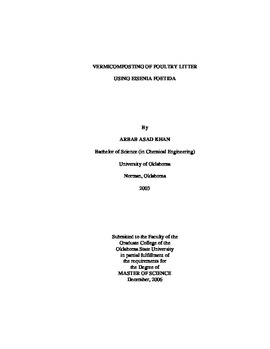| dc.contributor.advisor | Hamilton, Douglas W. | |
| dc.contributor.author | Khan, Arbab Asad | |
| dc.date.accessioned | 2014-02-25T00:20:53Z | |
| dc.date.available | 2014-02-25T00:20:53Z | |
| dc.date.issued | 2006-12-01 | |
| dc.identifier.uri | https://hdl.handle.net/11244/7947 | |
| dc.description.abstract | This study investigated the effects of microbial pre-composting, pH adjustment, feeding frequency and C/N ratio on vermicomposting of poultry litter. Poultry litter, whether raw, microbially pre-composted, or pH adjusted, needed bulking material for the survivability of earthworms. The earthworm biomass increased as C/N ratio increased from "As Is" to 50; however, most of the treatments reached a maximum earthworm growth at C/N of 50, with no significant differences for C/N ratio of 50 and above. The pH adjusted poultry litter and raw poultry litter at the feeding frequency of 1/8-weeks did not produce any positive growth, showing the need for microbial pre-composting for successful vermicomposting in windrows. The concentrations of volatile solids were found to be lower at C/N ratios of 30 and 50 as compared to 70 and above | |
| dc.format | application/pdf | |
| dc.language | en_US | |
| dc.publisher | Oklahoma State University | |
| dc.rights | Copyright is held by the author who has granted the Oklahoma State University Library the non-exclusive right to share this material in its institutional repository. Contact Digital Library Services at lib-dls@okstate.edu or 405-744-9161 for the permission policy on the use, reproduction or distribution of this material. | |
| dc.title | Vermicomposting of Poultry Litter Using Eisenia Foetida | |
| dc.type | text | |
| dc.contributor.committeeMember | Stone, M. L. | |
| dc.contributor.committeeMember | Wilber, G. G. | |
| osu.filename | Khan_okstate_0664M_2089.pdf | |
| osu.college | Engineering, Architecture, and Technology | |
| osu.accesstype | Open Access | |
| dc.description.department | Biosystems and Agricultural Engineering | |
| dc.type.genre | Thesis | |
